

Exploring our past to sort out myth from reality
Share this Page on
Facebook or Twitter

These are the voyages of the TimeShip Anachron.
Our Mission: To boldly explore the past, dispelling
mythinformation and mythconceptions
of American History along the way.
 Visit us on Facebook
Visit us on Facebook
Meet MythAmerica Series

Pt 1 Pt 2 Pt 3 Pt 4 Pt 5 Pt 6 Pt 7 Pt 8 Pt 9 Pt 10 Pt 11
The Not-So-Gay Nineties, Part 11 (Conclusion)
Party Like It’s…1897
The year was 1897. The US had been in an economic depression since 1877, exacerbated even more by the “Panic of 1893” that had left those in the lower classes of American society in desperate straits. Unemployment had become rampant, reaching, for instance, as high as 40% out of work in Michigan at one point. People were literally starving in the streets in the cities. For those who had work, an average annual wage for an unskilled factory worker would have been something like $400. But that was an average, which indicated perhaps what amount would provide a bare-
Allowing for inflation, the $400 would be the equivalent of about $10,000 now—or $4.80 an hour for a 40-
Back in their own time, the “gross” amount of that average paycheck would have been about $7.75 for a six-
Of course, there could be more than one income in a family. Lots of wives and children…even down to pre-
Like this boy, about age 10, working in a coal mine back around the turn of the 19th century. For 60 cents a day. For a 14 hour day.
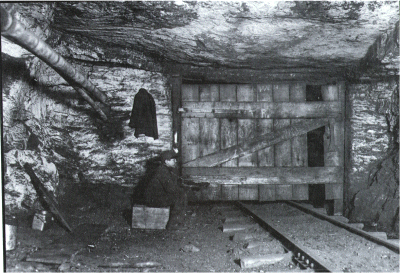
I met one little fellow ten years old in Mt. Carbon, W. Va., last year, who was employed as a “trap boy.” Think of what it means to be a trap boy at ten years of age. It means to sit alone in a dark mine passage hour after hour, with no human soul near; to see no living creature except the mules as they pass with their loads, or a rat or two seeking to share one’s meal; to stand in water or mud that covers the ankles, chilled to the marrow by the cold draughts that rush in when you open the trap door for the mules to pass through; to work for fourteen hours—waiting—opening and shutting a door—then waiting again for sixty cents; to reach the surface when all is wrapped in the mantle of night, and to fall to the earth exhausted and have to be carried away to the nearest “shack” to be revived before it is possible to walk to the farther shack called “home.” [From The Bitter Cry of the Children, 1906, John Spargo.]
Or these kids at a cotton mill.
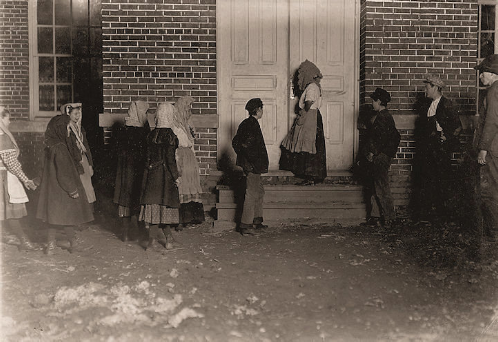
“Children on the night shift going to work at 6 p.m. on a cold, dark December day. They do not come out again until 6 a.m. [12 hour shift] When they went home the next morning they were all drenched by a heavy, cold rain and had few or no wraps. Two of the smaller girls with three other sisters work on the night shift and support a big, lazy father who complains he is not well enough to work. He loafs around the country store. The oldest three of these sisters have been in the mill for 7 years, and the two youngest for two years. The latter earns 84 cents a night. Whitnel, North Carolina.” [From the photo collection of photo-
Or this one, making 48 cents a day at a similar mill.
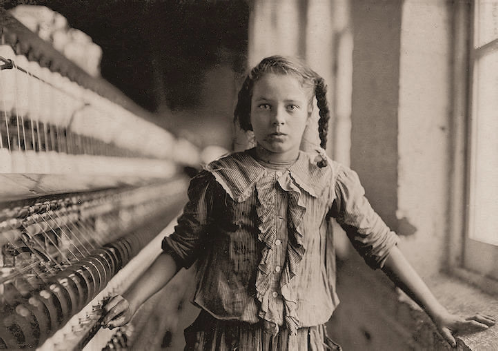
“One of the spinners in Whitnel Cotton Mill. She was 51 inches high. Has been in the mill one year. Sometimes works at night. Runs 4 sides – 48 cents a day. [Likely for a twelve hour shift.] When asked how old she was, she hesitated, then said, “I don’t remember,” then added confidentially, “I’m not old enough to work, but do just the same.” Out of 50 employees, there were ten children about her size. Whitnel, North Carolina.” [Hine]
Some families had more than four or five kids, so it was no doubt a relief to have them working as soon as possible to supplement the family income.

“Little Fannie, 7 years old, 48” tall, helps her sister in Elk Cotton Mill in Fayetteville, Tennessee, November 17, 1910. Her sister said, “Yes, she helps me right smart. Not all day but all she can. Yes, she started with me at 6 this mornin’.” The two girls belong to a family of 19 children.” [Hine]
So they’d start ‘em young to bring home the bacon. Such as this little five year old “newsboy” in St. Louis, Missouri, who sold papers to the public by jumping on and off moving trolley cars at the risk of his life. To make a few cents a day.
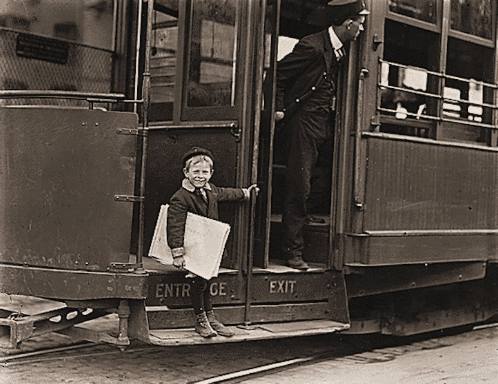
Or this eight year old newsie in Philadelphia, found selling papers in a big rain storm…having just recovered from his second attack of pneumonia.
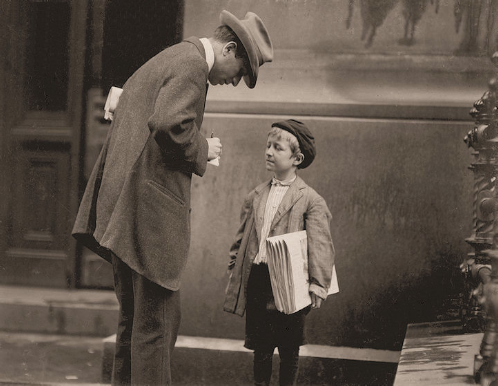
No, I doubt if any families like those these children belonged to in the 1890s and early 1900s ever splurged on a sirloin at Delmonico’s in New York. Even at “just” 85 cents.
The “Gay” ‘90s? Where on earth did we ever get the notion of the 1890s being a decade where Americans had a Gay Old Time?
We got it from the fact that the faces of tens of thousands of exhausted working children (and adults) have been mostly easily forgotten by the general public—while photos of the tiny group of wealthy people who made up the elite of the Gilded Age (and their possessions and their activities) are enshrined in coffee table books and in museums.
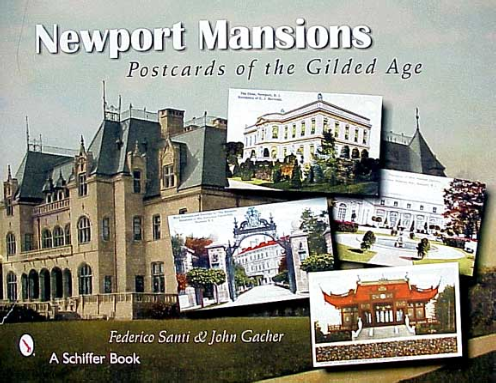
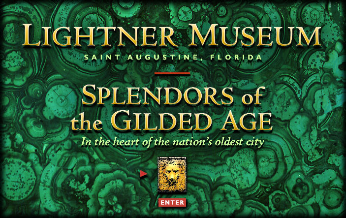
The reality is that while those kids and their parents were toiling away in the mines and the mills and factories and sweatshops for slave-
Like this event:
From a “gossip sheet” called “Town Topics” of 1897:
“Future generations will date every event in relation to the Bradley-
Pretty high estimation of an event! Admittedly the western world dates all events from the (presumed) date of Jesus’ Christ’s birth…B.C. to A.D. And ancient societies often dated events in relation to what “year of the reign of King So-
But then again, the kind of stunts the High Society people of the time pulled WERE “over the top” much of the time. Which, I think, is one of the main reasons people nowadays ignorantly speak of the hellish 1890s as the “Gay ‘90s.” It WAS full of “gaiety” for a favored few. In fact, “gay” was a favorite adjective to describe the lifestyles of the rich and famous of the time. (I would personally choose the adjective “obscene” for most of it…)
So just why should we, of later generations be all agog still about the Bradley-
I don’t know about my readers, but I’ve heard, at least in passing, since childhood of names of such really, really rich people of the Victorian age as the Vanderbilts, the Rockefellers, and the Carnegies. But until recently I’d never heard of Bradley Martin and his wife Cornelia.
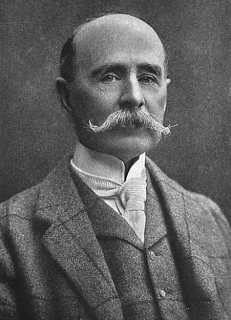
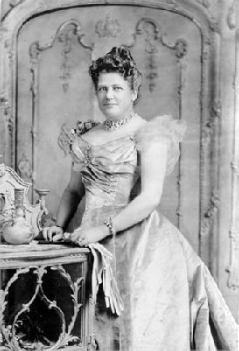
Bradley and Cornelia Martin started styling themselves “The Bradley-
Turns out there were quite a few filthy rich people of the time who were influential in “New York Society” but whose names never became household words in the rest of the country like the biggest of the Robber Barons. The Bradley-
They started out their marriage with a bit of inherited wealth from both sides of the family. (Still, only enough to reach the lower rungs of the Richness Ladder of the time, Lower High Class, I guess.) Then Mrs. Bradley-
The Bradley-
In the Winter and Spring of 1883, Mrs. Martin's name began to appear among the patronesses of fashionable entertainments…[Source]
She started out gradually, giving lavish dinners and small balls. But by late 1896 she had her sights set on the heights. As described in this snippet from the New York Times in February 7, 1987, regarding the Bradley-
Mrs. Martin is credited with two separate ambitions, which, it is said, induced her to give the coming ball. These are, first, a desire to round off her society career in New York with the most superb entertainment the city has ever seen, and, second, a wish to have her ball surpass the famous Vanderbilt one of 1883.
Yes, it was her intent to hold the biggest High Society Potlatch in history, and burn more wealth doing it than had ever been done before.
She succeeded. She managed to blow almost 9 million (modern) dollars on a single evening to entertain fewer than 800 guests. That comes to over 11,000 (modern) dollars per guest. For a ball that lasted about five hours.
Guests were requested to come in costumes that impersonated famous people (most chose to impersonate royalty) from the 16th-
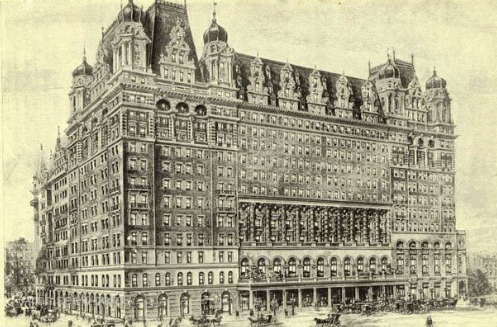
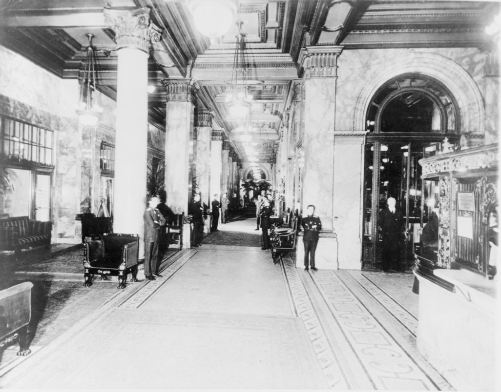
(This was the "original" Waldorf-

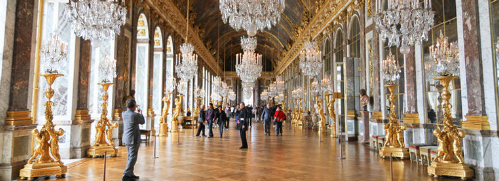
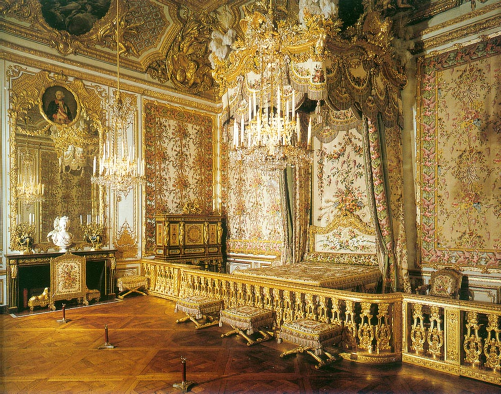
The Society people of the Gilded Age really, really admired the splendiferousness of Versailles and that period of the French kingdom. So they tended to try to imitate aspects of it a LOT. Mrs. B seems to have gone above and beyond the call of duty with her ball. Here’s how Mrs.’s B’s brother-
The best way I can describe what is always known as the "Bradley Martin Ball," is to say that it reproduced the splendour of Versailles in New York, and I doubt if even the Roi Soleil [Sun King—Louis XIV, 1643-
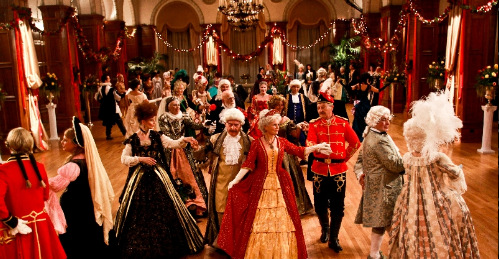
(Above is a still photo from a video “recreation” of the Bradley Martin Ball done for a National Geographic special series called “Party Like the Rich and Famous.)
”I do not think there has ever been a greater display of jewels before or since; in many cases the diamond buttons worn by the men represented thousands of dollars, and the value of the historic gems worn by the ladies baffles description.
Yes, “baffles description” is probably a good way to put it. Not only did the richest families of New York pull out their own family heirlooms to bedeck themselves, they seem to have raided the attics of their rich buddies from all over the country. As the New York Times writer put it in the pre-
… I know of cases where family jewels and other finery have been drafted in the service from friends East, West, and South. You know some of the old Southern families, especially in Maryland, South Carolina, and Georgia, have very valuable gems and heirlooms that date back to Colonial days, and they managed to preserve them during the dreadful times of the war. Now some of our Four Hundred folks, in days gone by, have been on such intimate terms with their Southern friends, and have managed to entertain them so handsomely, that it comes hard to refuse when they make special requests for loans of their treasures. Some of the old Oglethorpe gems from Georgia, and the Fairfax gems from Virginia, and a lot of rare old bracelets and brooches from Savannah will figure in the Bradley Martin pageant, and go to swell Gotham's reputation for antique gems. It's just dreadful to think of the way some of these guests will flash and strut in borrowed plumage of all sorts, family heirlooms they never had the least right or title to wear in public.
They also raided all the antique jewelry shops in the Big Apple, as described by this Times writer:
There is no estimating the value of the rare old jewels to be worn at the Bradley Martin ball. All the jewelers who deal in antiques say they have been cleaned out of all they had on hand, and people still keep calling for old buckles, snuff boxes, lorgnettes, diamond or pearl studded girdles, rings, and, in fact, every conceivable decoration in gems.
All this, of course, is outside of the costly jewels held as heirlooms by the old families of New York. These have been taken from safety vaults and furbished up for the occasion in such quantities that the spectator will be puzzled to know where they all came from.
But how else do you impersonate European royalty if you haven’t got a huge amount of bling?! Among the women there were at least 50 Marie Antionettes present that evening, 10 Madame Pompadours, 8 Madame De Manintenons (second wife of the Sun King), 3 Catherine the Greats, 1 Queen Louise of Prussia (1600s), and countless other queens, princesses, and other assorted royalty. Including even a Pocahontas.
(I don’t quite know what to think of Miss Edith Cushing, who the Times noted showed up as a “Puritan maiden. In white China silk with round collar of mouse-
Here’s a typical female attendee…
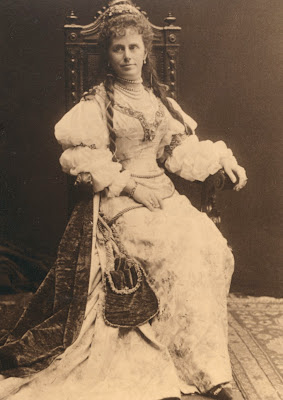
Among the men…Bradley Martin himself did a King Louis XV impression. Famous Robber Baron Banker JP Morgan showed up as French playwright and actor of the 1600s, Moliere. Two George Washingtons were there, along with Henry VIII…and an Indian Chief…
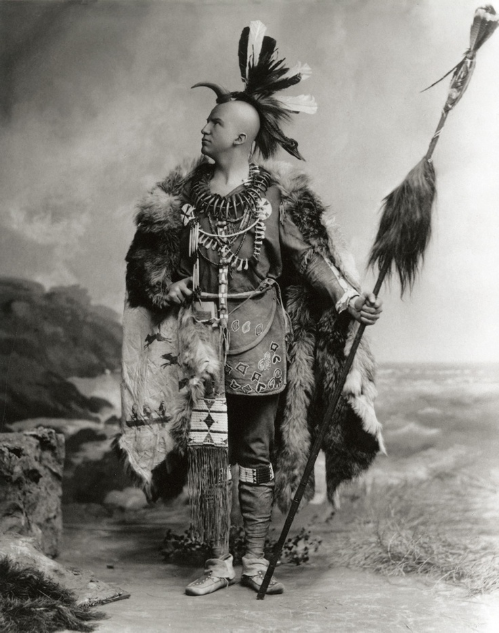
And lots of other kings and nobles and knights and such.
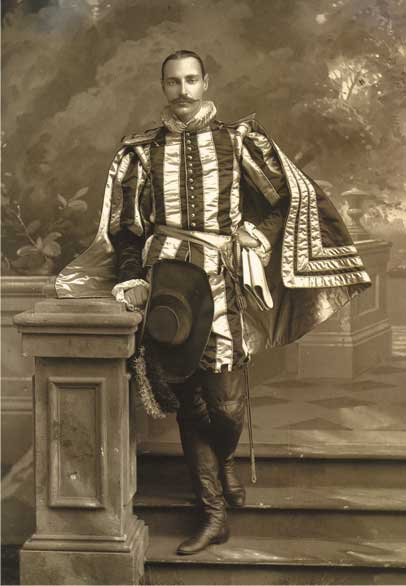
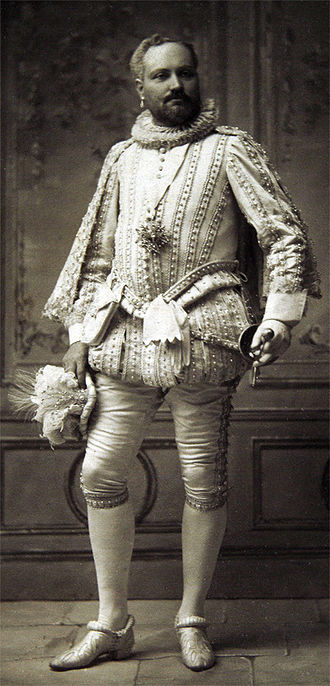
Here’s a postcard of a diorama of a scene from the Bradley-
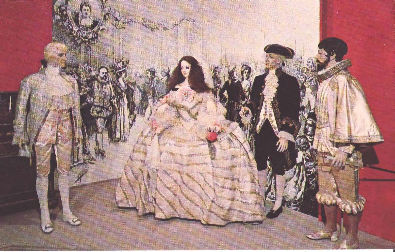
Mrs. Bradley-
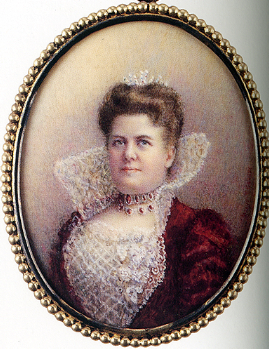
You can see, in her portrait above from that night, a diamond and ruby necklace made up of two bracelets actually owned originally by the daughter of Louis XVI and Marie Antoinette. Just as an aside about the unusual costume…here’s what Mary Queen of Scots looked like in a typical “Victorian era” painting.
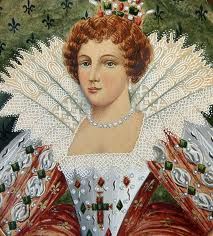
I’ve looked all over and can’t find any painting of Mary from any period that has a dress…and particularly a collar…that looks a thing like the one Mrs. B was wearing. But as one article on the web that I read noted…she does bear a STRIKING resemblance in her costumed portrait to another famous Victorian Era queen!
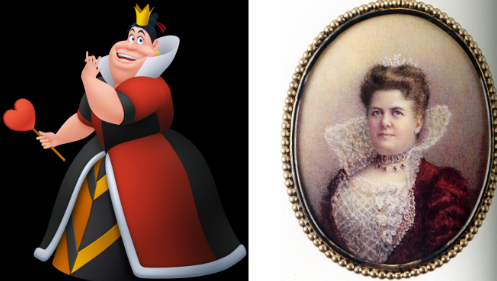
Honestly—I’m not all that convinced that some Disney artist didn’t spot Mrs. B’s portrait somewhere and model the Queen of Hearts and her amazingly high collar after it!
Although Mrs. B’s costume was impressive, and all the jewels she was wearing that night were said to be worth $100,000 ($2.7 million now), she was bested by John Jacob Astor’s wife, one of the Marie Antoinettes of the evening, who was said to be wearing jewels worth twice as much.
Obviously, the unwashed masses of New York were not afforded even a tiny glimpse of all these goodies. Guests were driven right up to the doors of the Waldorf and whisked right in. They either had cloaks on covering their lavish costumes and all their bling, or brought in trunks with what they needed, and used dressing rooms in the hotel to bedeck themselves. No, you couldn’t peek in a window or a door either. From the Times again:
While this [putting up of flowers and other decorations] was going on the sound of hammers came from the side entrance, or alleyway, at the extreme west end of the hotel. Carpenters were engaged in boarding up the windows of the first and second floors. If people in the adjoining house had made arrangements to oblige their friends with a free view of the ballroom spectacle, they can call back all invitations. It will be a cold and cheerless night for them. The same lock-
Mrs. Martin has given the most rigid orders to this effect. Not only will there be no chance whatever for outsiders to get a peep at the pageant, but Manager Boldt has been directed to see that no interlopers are allowed, on any pretense. When the corps of decorators have finished their work, none but guests, maids, attendants, musicians, and waiters will be allowed to enter. No attempt will be made to furnish the attendants with any costume. Maids and waiters will appear in regulation garb.
In fact, just in case anyone was inclined to try to get too close to the Crème de la Crème, Teddy Roosevelt (who was president of the board of police commissioners at the time) stationed something like 200 police around the building and lining the sidewalks, ordered the street barricaded in front of the hotel, and positioned “ten of his tallest men” on either side of the walk guests would have to take from the curb to the doorway. The Bradley-
‘Twould seem to be that all this was because there was kind of a gut feeling in New York that just maybe the starving masses might not be too impressed with such an extravagant display of excess flaunted right in the middle of their abject misery. And thus they might try to take out their frustrations on those doing the flaunting.
Nah. There was a lot of grumbling in editorials in some papers across the country about how arrogant and thoughtless and lacking in discretion such a blatant display of excess of greed and conspicuous consumption was in the midst of the economic desperation of so many. But the poor themselves just went right on starving meekly and quietly. There was no protest on the streets at all.
So meanwhile back at the ball, the guests all arrived around 11 PM. They were ushered in to be presented before the Queen of the Ball by a “lackey” who announced their real names and faux identities. Once that process was done, they passed through all the decorated areas so they could be impressed by the flowers and greenery for the shindig, which also cost a fortune. From the Times again:
In addition to the 400 odd people employed here [doing the decorating of the Waldorf ahead of time], a great army of poor folks in Alabama have been engaged in gathering clematis vines for the affair.
… An enormous drain has been made for the flowers, not only on all the florists in this region, but on neighboring cities as well. The hunt for orchids—and thousands will be required in the decoration scheme—has been prosecuted at Albany, Rochester, and several other point, while the large hothouses of Small, in Washington, D. C, have been forced to the limit, not only of orchids, but on all the floral beauties to be drafted into the service.
To give an idea of the magnitude of the decorations, the florist's force had used 35,000 of the rich galax leaves from South Carolina before midnight. Some time before daylight they were to begin with the roses. In the large ballroom the color scheme is confined to pink and green; in the small ballroom, where Mrs. Martin will receive her guests under a gorgeous canopy of tapestry and roses, the color scheme is to be pink, white, and green, while in the supper room the decorations will consist of American Beauties, a profusion of yellow roses, and a liberal display of the dainty white mimosa sprays, grown specially for this occasion. None of these delicate and perishable garlands will be in place before this afternoon.
An almost incredible amount of asparagus vine will be used in parts of the display. This is the African variety, so called, as it grows in its native state in the African jungles. Raised in hothouses, it is very costly, indeed, but the florist has carte blanche. [Or, as the saying goes, he was told to “spare no expense.”]
And certainly no expense was spared for food and drink, either.
In addition to generous quantities of whiskey, brandy, and still wines, Cornelia Bradley-
I thought that a “case” of champagne, at least these days, includes just a dozen bottles. But several official accounts I’ve seen of the B-
Well, they seem to have packed away a lot more than just gallons of champagne. After having eaten their own dinners earlier in the evening (a number of the Elite held “pre-
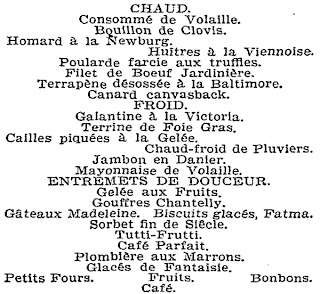
I can’t read French (although I do recognize “Tutti Frutti.” And “bonbons.”) But English versions of this story mention that the words above indicate, among other things, lobster, caviar-
Why am I put in mind of a 1980 Saturday Night Live skit featuring people in a supposed Roman “vomitorium”…allegedly a place with troughs where people at a Roman pig-
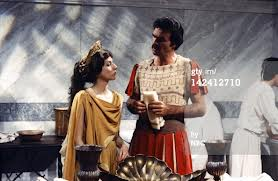
Nah, I’m pretty sure the Waldorf-
Then again, rumor has it that quite a few people were actually bored by the party and headed out fairly early once they had made their appearance in their finery…and sipped a bottle or two…or three, or five…of champagne. But a significant number stayed until close to the end, which was at about 4 AM.
Bradley Martin’s brother Thomas commented in his memoir about the criticism that the Ball had received in the press. He then gave a vivid description of the shindig, with details such as those I give above, and concluded with his own observation:
The power of wealth with its refinement and vulgarity was everywhere. It gleamed from countless jewels, and it was proclaimed by the thousands of orchids and roses, whose fragrance that night was like incense burnt on the altar of the Golden Calf.
I cannot conceive why this entertainment should have been condemned. We Americans are so accustomed to display that I should have thought the ball would not have been regarded as anything very unusual. [Source]
Yeah. Why should there have been any nay-
Why on earth would anyone criticize someone for burning their own money to throw a five hour party for a passel of drunken gluttons dripping in jewels? Why, it’s the American Way. (Not unchristian and uncivilized like those ol’ potlatches thrown by the heathen Kwakiutl Indians, who needed to be brought up to the Great White Way of doin’ things. Isn’t that what the “White Man’s Burden” was all about??)
Certainly wouldn’t want to put a guilt trip on these folks who were just spending their own hard-
$10,000 could pay the average wages of eighteen New York workingmen for a year, pay the average wages of 6,240 workingmen for a day; support a family at average workingmen’s wages for fifteen years; … buy half a ton of coal each for 7,000 families…
As the fifty Marie Antoinettes at the B-
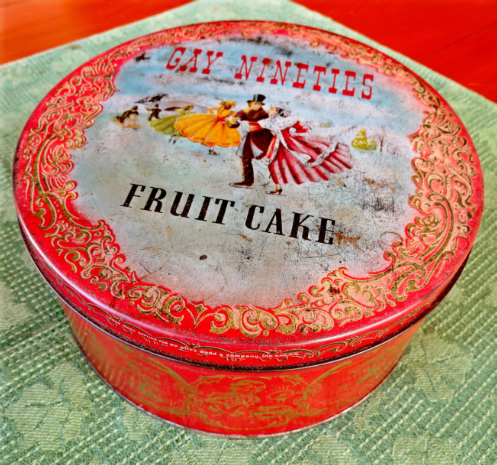
For after all, it was the “Gay Nineties.”